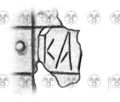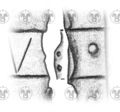SZ-30
| Inscription | |
|---|---|
| Transliteration: | ka[? ?]isθi : luχe : ̣p̣umis : l[ ]θiaḳ[??]auþile : ẹḷuku : ̣ |
| Original script: | |
|
| |
| Object: | SZ-30 situla (bronze) |
| Position: | inside |
| Frame: | |
| Script: | North Italic script |
| Direction of writing: | dextroverse |
| Letter height: | 1.2 cm – 2.5 cm |
| Number of letters: | 35 |
| Number of characters: | 40 |
| Number of lines: | 1 |
| Craftsmanship: | embossed |
| Current condition: | damaged, fragmentary, restored |
| Date of inscription: | 5th–4th centuries BC [from object] |
| Date derived from: | typology [from object] |
|
| |
| Language: | Raetic |
| Meaning: | unknown |
|
| |
| Alternative sigla: | IR 29 LIR SA-22 |
| Sources: | Schumacher 2004: 139 |
Images
|
Inscription SZ-30 - fragment A.
|
Inscription SZ-30 - fragment B.
|
Inscription SZ-30 - fragment C.
|
Inscription SZ-30 - fragments D and E.
|
Inscription SZ-30 - fragment A.
|
|
Object SZ-30 situla with inscription SZ-30 - fragments A-K.
|
Object SZ-30 situla with inscription SZ-30.
|
Commentary
First published in IR. Autopsied by TIR in November 2013.
Pictures in IR (photo tav. XLI and drawing = LIR).
The characters are struck from what was apparently the inside of the situla, and are usually read from this side, even though dextroverse inscriptions are unusual. It is unlikely that the strokes would have been visible on the outside of the vessel even in the absence of copper rust. (Compare, however, IT-5 where the positive side seems to have been the face side.) This raises the question of when and why the signs were embossed. It is generally assumed that the inscription was applied secondarily: The situla was dismantled and inscribed, possibly for votive purposes (suggested also by the presence of the word eluku), on what had been the inside, apparently making use of two decorative lines as a frame for the letters.
On fragment A: The presence of the rivetted edge before ![]() suggests that this fragment bears the beginning of the inscription. A discolouration is visible along the breaking edge in the lower half of the line, maybe indicating a stroke (
suggests that this fragment bears the beginning of the inscription. A discolouration is visible along the breaking edge in the lower half of the line, maybe indicating a stroke (![]() ?). Length 2.1 cm.
?). Length 2.1 cm.
On fragment B: Based on the reconstruction of the situla, the second part of the inscription. If fragments A and B fit together as shown in the drawing, as few as three or four letters may be missing between ![]() and
and ![]() . The very tip of the letter before the first
. The very tip of the letter before the first ![]() is visible. A small piece missing in the upper area where fragment B was broken (see SZ-30 situla) damages the separator (the uppermost dot being gone) and the sign following it, but no other reading than
is visible. A small piece missing in the upper area where fragment B was broken (see SZ-30 situla) damages the separator (the uppermost dot being gone) and the sign following it, but no other reading than ![]() is plausible. Length about 18 cm.
is plausible. Length about 18 cm.
On fragment C: If fragments B and C fit together as shown in the drawing, about ?? letters are missing between ![]() and
and ![]() .
. ![]() is damaged in the middle area, the upper bar being gone; no white inlay in the remaining bar. The right part of the fragment only shows the upper parts of the following letters: an angle representing the tip of
is damaged in the middle area, the upper bar being gone; no white inlay in the remaining bar. The right part of the fragment only shows the upper parts of the following letters: an angle representing the tip of ![]() ,
, ![]() or
or ![]() , followed by the tip of an oblique stroke, most probably
, followed by the tip of an oblique stroke, most probably ![]() , and one of a hasta. Length 7.2 cm.
, and one of a hasta. Length 7.2 cm.
On fragments D and E: The fragments have not been joined together by the restaurator like the fractions of fragment B, but belong together without a doubt. The size of the lacuna between fragments C and D is not securely determinable (see SZ-30 situla). Before ![]() , the upper tip of an oblique stroke. A hole is located right at the tip of
, the upper tip of an oblique stroke. A hole is located right at the tip of ![]() – while it is deep and irregular and does nor look intentional like the dots of the separators, no similar defect can be found on the situla's surface. See NO-13 for possibly a similar execution of the special character and Þ for details.
– while it is deep and irregular and does nor look intentional like the dots of the separators, no similar defect can be found on the situla's surface. See NO-13 for possibly a similar execution of the special character and Þ for details. ![]() and
and ![]() of eluku are damaged by the break between the two fragments, but the reading is non-ambiguous. Fragment G, fitting neatly onto fragment A, bears the last word of the inscription. Length 4.5 cm.
of eluku are damaged by the break between the two fragments, but the reading is non-ambiguous. Fragment G, fitting neatly onto fragment A, bears the last word of the inscription. Length 4.5 cm.
Finally, back on fragment A, to the left of the rivetted rim, a separator marking the end of the inscription right after eluku. The uppermost dot is missing.
The characters are neatly and consistently executed, with ![]() appearing always with short bars,
appearing always with short bars, ![]() with the bar rising in writing direction,
with the bar rising in writing direction, ![]() with the upper angle opening in writing direction,
with the upper angle opening in writing direction, ![]() shorter than the other letters, and a separator consisting of three dots. The only difficulty concerns the ever-problematic characters for l and p: All three Northern variants
shorter than the other letters, and a separator consisting of three dots. The only difficulty concerns the ever-problematic characters for l and p: All three Northern variants ![]() ,
, ![]() and
and ![]() occur in the inscription.
occur in the inscription. ![]() in eluku and )auþile is clear, and
in eluku and )auþile is clear, and ![]() in pumis is the standard Sanzeno-type p, so
in pumis is the standard Sanzeno-type p, so ![]() in luχe and at the beginning of a lost word could be read either l or p. It does seem strange that in such a tidy inscription the writer should have made a grave mistake like this; it remains to be determined whether
in luχe and at the beginning of a lost word could be read either l or p. It does seem strange that in such a tidy inscription the writer should have made a grave mistake like this; it remains to be determined whether ![]() with the bar on top turned in writing direction is not a character distinct from the other two rather than a variant of either or frequent evidence of a common mistake. (See L for details and ??? for other inscriptions containing all three characters.)
with the bar on top turned in writing direction is not a character distinct from the other two rather than a variant of either or frequent evidence of a common mistake. (See L for details and ??? for other inscriptions containing all three characters.)
The inscription appears to be the longest document of the Raetic language which has so far come down to us; unfortunately, it is shortened to unknown extent by the disintergration of the object. Of the complete words, only eluku is attested in other Raetic inscriptions. luχe or puχe lends itself to various interpretations; the segmentation of pumis as a personal name plus genitive suffix is not implausible, but not confirmable in the absence of other attestations of the name. Only one pertinentive form can be found in )auþile.
Bibliography
| IR | Alberto Mancini, "Iscrizioni retiche", Studi Etruschi 43 (1975), 249–306. |
|---|---|
| LIR | Alberto Mancini, Le Iscrizioni Retiche [= Quaderni del dipartimento di linguistica, Università degli studi di Firenze Studi 8–9], Padova: Unipress 2009–10. (2 volumes) |





